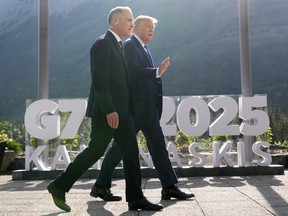NP View: Mark Carney's Trumpian moment
This is the way the liberal economic order ends
Author of the article: By National Post View
Published Jul 19, 2025
Last updated 22 hours ago
4 minute read
321 Comments

Prime Minister Mark Carney, left, walks with U.S. President Donald Trump at the G7 Summit in Kananaskis, Alta., on June 16.
In “The Art of War,” the Chinese general Sun Tzu wrote: “If you know the enemy and know yourself, you need not fear the result of a hundred battles.” By imposing tariffs on Canada’s non-American trade partners, Prime Minister Mark Carney is taking that advice one step further — becoming the enemy he was elected to confront.
Throughout history, the prevailing international order has been overthrown countless times, but it doesn’t always go out with a bang, as it did in 1914 when Archduke Franz Ferdinand took a bullet to the jugular, precipitating the First World War and leading to a precipitous decline in international trade.
At our current moment in history, we are witnessing the process of trade liberalization that was started after the Second World War go out with a whimper.
The dismantling of the postwar economic order was started by U.S. President Donald Trump, who began by targeting Canada and Mexico, and then extended his tariffs to the rest of the world.
But in every crisis lies an opportunity. For Canada, the opportunity was not only to develop the natural resources we have allowed to sit idle for years, but to forge an alliance of free-trading nations that could act as a counterweight to Trump’s protectionist policies.
Carney is not only squandering this unique opportunity, he’s introduced policies that will only serve to broaden the global trade war.
This week, the prime minister announced a series of measures intended to protect Canada’s steel industry after Trump increased tariffs on Canadian steel and aluminum to a punishing 50 per cent. Some of the more sensible policies include a pledge to use Canadian steel for domestic infrastructure projects and funds to help retrain affected workers.
But Carney also announced sweeping tariffs on foreign steel imports, including from countries that Canada has free trade agreements with.- NP View: Mark Carney needs a chainsaw, not a scalpel
- NP View: Week one, and Mark Carney’s cabinet is even worse
Going forward, the tariff rate quota will be set at 50 per cent of 2024 levels for countries that don’t have trade agreements with us and 100 per cent for those that do. Steel imports above those levels will be slapped with a 50 per cent tariff.
On the surface, the Liberals are following a certain logic: Trump’s across-the-board steel and aluminum levies will lead to a glut of supply in producing countries, which they will try to dump into the Canadian market at rock-bottom prices, putting our domestic industry at risk.
But in doing so, Carney is all but inviting our trade partners to bring in retaliatory tariffs against Canadian products.
Following the Trudeau government’s decision to impose a 100 per cent tax on Chinese electric vehicles and a 25 per cent levy on its steel and aluminum last fall, Beijing retaliated by sanctioning numerous Canadian products — including canola oil, fish, seafood and pork — which has had a deleterious effect on our agriculture industry at the most inopportune time.- Toronto police identify 14-year-old suspect in fatal stabbing of Shahnaz Pestonji, 71, in parking lot
- Danielle Smith says pulling Alberta out of supply management is worth considering
- Michael A. Sachs: Why I'm moving my family to the United States
The worst part is that Carney’s tariffs are also being imposed on countries that have free trade deals with Canada, which will surely violate the spirit, if not the text, of those agreements.
If any of those countries are found to be dumping steel into Canada at below-market rates, the proper course of action would be to use the dispute-resolution mechanisms contained in our existing agreements, rather than imposing blanket tariffs on everyone.
When he made his announcement at a steel company in Hamilton, Ont., on Wednesday, the prime minister said that, “Moving forward, we must diversify our trade relationships.”
But who’s going to want to do business with a country that stabs its closest allies in the back? And how are we going to entice more countries to open their markets to Canadian products when Ottawa has shown that it can’t be trusted?
Unfortunately, Carney has been so consumed with striking a deal with the United States — which he now admits is unlikely to fully eliminate tariffs on Canadian products — he has largely neglected the other side of the coin: expanding our trading relationship with other countries.
Yes, he travelled to Europe in June and signed a security and defence pact with the European Union, but it merely reiterates our commitment to the free trade deal we signed in 2016 but still hasn’t fully come into force because not all EU member states have ratified it.
If Carney can’t even convince his pals in Europe to ratify an agreement that’s already been negotiated, it’s hard to believe he will have much luck convincing other potential partners to cut new deals with us.
Especially given that one of the first things Canada’s 45th Parliament did following the spring election was pass a law protecting supply management from future trade negotiations.
This is the way the liberal economic order ends. Not with a bang but a whimper. Not with a mercantilist leading the most powerful economy on earth but with other world leaders emulating his tactics and playing right into his illiberal hands. |





